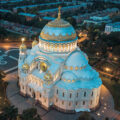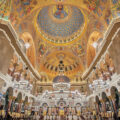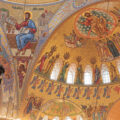- Внутреннее убранство / Interior decorations
- Работа над восстановлением росписей собора / Wall-paintings restoration
The Kronstadt Naval Cathedral of St. Nicholas is located at Yakornaya Square in the center of the historical part of Kronstadt. It is the largest military cathedral built in the Russian Empire. It stands out as a building of great urban planning importance and the architectural centerpiece of the square and the entire city.
The cathedral was designed by the outstanding engineer and architect Vasily Kosyakov. The structure is representative of Byzantine architecture as it was perceived in the 1900s. Russian architects often turned to Byzantine culture, and Kosyakov used these motifs consistently since the very beginning of his career. This commitment truly manifested itself in the design of the Kronstadt Cathedral, where the architect got the chance to build something on the scale of Hagia Sophia in Constantinople (now Istanbul, Turkey), bringing the proportions of the structure in line with its historical prototype.
However, the Kronstadt Naval Cathedral is far from being a blind recreation of Byzantine architecture. The cathedral and especially its interior contain references to various historical styles and reflect the architect’s commitment to using the best technologies and techniques of the past. The interior was designed to be a representation of the sea element, with the ornamental starry sky above, sea depths below, and the parishioners finding themselves between the heavens and the depths of the sea. The interior was painted by the outstanding Russian painters Mikhail Vasiliev and Kuzma Petrov-Vodkin.
The cathedral’s construction was largely financed by naval crews, members of the imperial family, and private individuals. Already at the planning stage, it was viewed as the main cathedral of the Russian Navy. Inside, memorial plaques were placed with the names of naval officers, priests, prominent members of the lower ranks of the Navy, and naval crews who died in the line of duty.
The cathedral was consecrated in the name of St. Nicholas the Wonderworker in 1913 during the celebration of the Romanov Tercentenary. But this was on the eve of World War I, and in the 20th century, the Kronstadt Cathedral witnessed many tragic events.
After the October Revolution of 1917, the cathedral remained in the hands of the church, but in 1929, in the wake of anti-religious sentiments, it was alienated to cultural institutions. The crosses were removed, and in 1932 the building was converted to a club and a cinema.
The cathedral survived World War II and was reconstructed. The Museum of the History of Kronstadt opened there in 1953, and later, the structure was also used as a club house for the Kronstadt garrison. In 1975, the Naval Cathedral was recognized as a monument of architecture.
The greatest damage was caused to the structure at the end of the 20th century, when first individual parts of the building and then virtually the entire cathedral stopped being used. The history of the Naval Cathedral clearly shows the need for continuity in the preservation of monuments that should not depend on economic and political conditions because the withdrawal of support leads to the loss of original architectural fragments and expensive restorations.
At the turn of the 20th and 21st centuries, the public and the representatives of the executive power, Russian Orthodox Church, and the Leningrad Naval Base unanimously expressed their desire to preserve the Kronstadt Cathedral as an architectural monument and a memorial to naval mariners. Since 2009, the International Charitable Foundation “Kronstadt Naval Cathedral in the Name of St. Nicholas the Wonderworker” has been actively involved in its restoration.
Unfortunately, a significant part of the cathedral’s interior decorations was either lost or severely damaged. Extensive research was carried out, and fragments of the original decoration were uncovered from under the later layers during restoration works. Restoration artists made active use of the architect’s sketches of the interior and the vast photo archive of the beginning of the 20th century. Interior decorations were recreated by outstanding craftsmen and creative teams from all over the country. As a result, the cathedral was restored as close as possible to its original appearance. The paintings of the main dome, sails, arches, and galleries were done by the artists of the Vifaniya company headed by Nikita Nuzhny. The restoration works were carried out under the strict supervision of the state monument protection authorities.
The Kronstadt Naval Cathedral was designed as a monument to all fallen seamen and the main place of worship of the Russian Navy. It rises high above the island and the sea, and its dome is visible from all points of the Nevsky fairway and from Vasilyevsky and Elagin Islands. Today, it serves as the Cathedral of Russian Naval Glory, a collection of naval relics, and a memorial to naval heroes.
The Kronstadt Naval Cathedral is included in the list of locations of the UNESCO World Heritage Site “Historic Center of Saint Petersburg and Related Groups of Monuments.”
Arseny Skvortzov-Pitersky, Art historian, Vifaniya LTC




